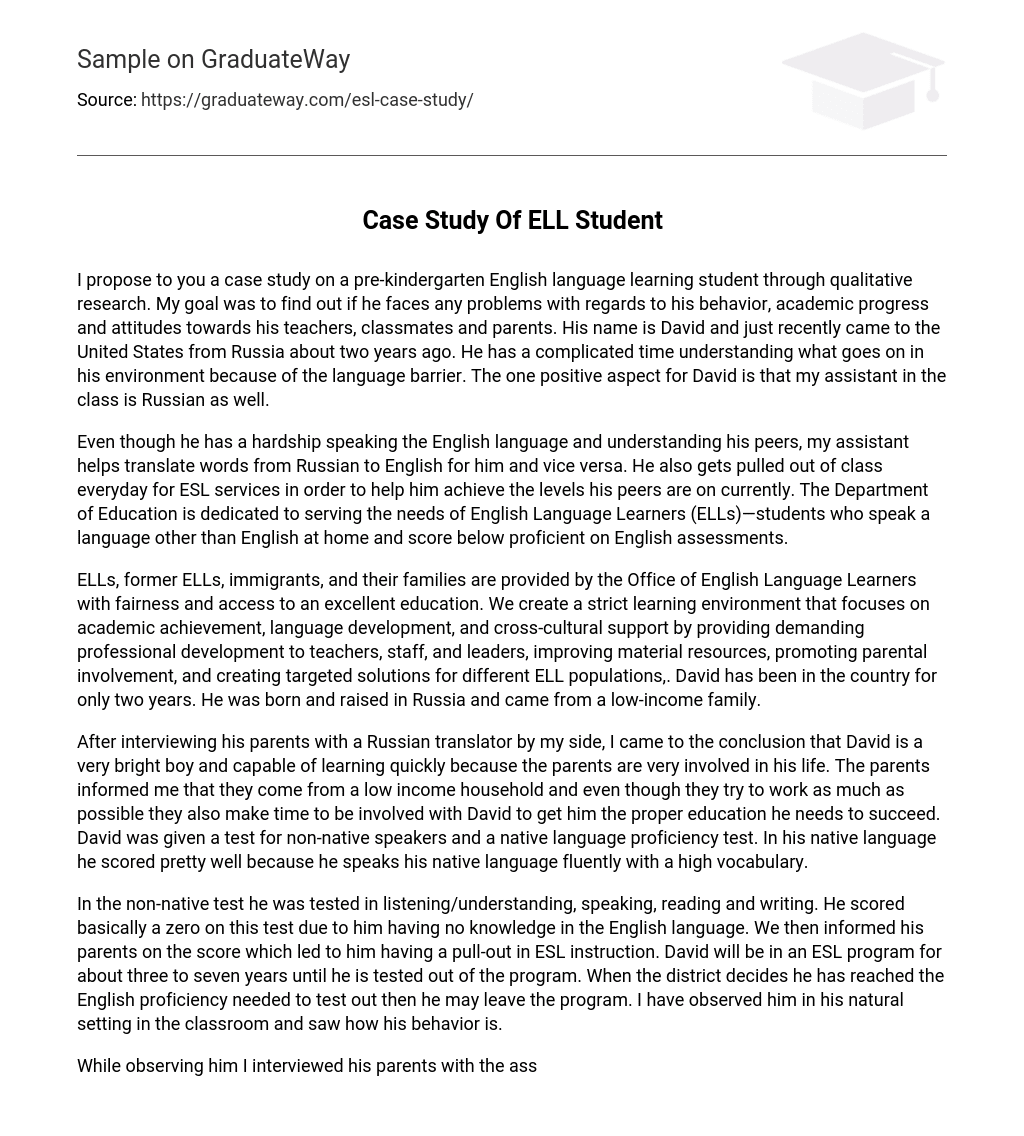The aim of the proposed qualitative research case study is to examine the experience of David, a pre-kindergarten student who is acquiring English as a second language. The study aims to detect any challenges that David encounters in relation to his behavior, academic advancement, and attitudes towards teachers, classmates, and parents. Following his relocation from Russia to the United States two years ago, David has faced difficulties comprehending his surroundings due to the language barrier. Nonetheless, a positive aspect is that there is a Russian-speaking assistant present in his class.
Despite the difficulties with English, my assistant helps with translating Russian and English words in both directions. They also actively participate in daily ESL services to improve their skills and keep up with classmates. The Department of Education is dedicated to providing support for English Language Learners (ELLs) who have a different native language and do not reach proficiency on English assessments.
The Office of English Language Learners (ELL) is dedicated to ensuring equal opportunities and a high-quality education for ELLs, former ELLs, immigrants, and their families. Our initiatives aim to create a challenging learning environment that prioritizes academic success, language development, and cross-cultural support. To achieve this objective, we offer comprehensive professional development programs for teachers, staff, and administrators while also improving material resources. Additionally, we actively promote parental involvement and implement customized solutions for various ELL populations. As an illustrative example of the impact of our work, consider David—a recent immigrant from Russia who comes from a low-income background and has only been in the country for two years.
David’s intelligence and quick learning abilities were evident during the interview with his parents and a Russian translator. This can be attributed to the active involvement of his parents in his upbringing, despite their low-income status. They work diligently to juggle their job responsibilities while prioritizing David’s education for future success. As part of the evaluation process, David underwent tests designed for individuals who are not native speakers, as well as a proficiency test in his native language. He performed exceptionally well in this assessment, showcasing fluency and an expansive vocabulary.
The non-native test assessed the student’s listening/understanding, speaking, reading, and writing abilities. Unfortunately, due to his limited knowledge of the English language, he received an almost zero score. Consequently, his parents were notified about his score and he was enrolled in an ESL instruction program. It is expected that David will remain in this program for a period of three to seven years until he demonstrates enough proficiency in English to exit the program. Once the district determines that he has achieved the necessary level of English proficiency, he will be allowed to leave the program. During my time in the classroom, I had the chance to observe his behavior within his natural environment.
During my observation of David, I conducted interviews with his parents and the assistant to gather information about him and his environment. Additionally, I observed his classroom behavior, paying special attention to his interactions with others. I took note of whether he made attempts to communicate or if he preferred being alone. Although academics were not heavily emphasized in preschool, David demonstrated understanding of basic concepts such as letters, numbers, shapes, and colors. Moreover, he showed improvement in recognizing letter sounds since the start.
Despite still facing challenges when communicating with his peers, the students are able to understand the ELL in their own way. I observe the students taking the initiative to correct him occasionally when he struggles with certain words, often guessing his intended meaning and completing his sentences for him. Younger ELLs tend to have an easier time acquiring language skills, and their peers are usually more supportive in this process. However, as ELLs grow older, fellow students may be more inclined to mock them rather than assisting them in learning the language.
I arranged an interview with his parents to discuss David’s progress and gather information about him. A translator is necessary since his parents do not speak English. I inquired about David’s behavior and attitude towards schoolwork at home, as well as how he responds when asked about his classmates and school in general. I also wanted to know if he eagerly looks forward to going to school, enjoys learning, and has any friends he interacts with. Additionally, I discussed David’s behavior in the classroom, noting that he occasionally participates but also sits quietly at times.
Despite a language barrier, I have noticed the student putting in extra effort to understand and participate in various activities. He tries his best to respond when addressed and actively engages with his peers during group tasks. However, during circle time, he doesn’t pay full attention as he struggles to comprehend the spoken language. Reading stories poses the most difficulty for him as he lacks sufficient English skills to fully grasp the content, relying mainly on visual cues from the book’s illustrations. Given this language challenge, he requires additional support beyond simply being pulled out for English as a Second Language (ESL) classes.
In order to support David’s academic and social development, I believe that his lack of understanding in the language will hinder his progress. To aid in his comprehension, I suggest having a Russian translator with him. Since coming to the United States, David has shown great academic potential; however, he is being held back by the language barrier. Another possibility is proposing the inclusion of a skilled Russian-speaking teacher to accompany him. This personalized assistance would likely result in faster language learning and improved understanding of classroom content through translation.





